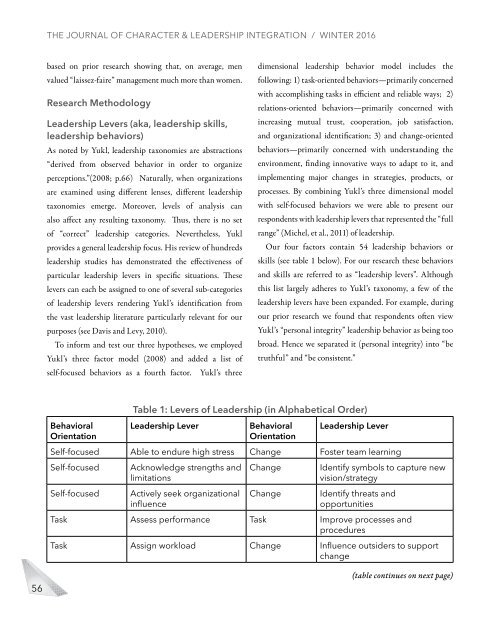PROFESSION OF ARMS
Yi5mwL
Yi5mwL
Create successful ePaper yourself
Turn your PDF publications into a flip-book with our unique Google optimized e-Paper software.
THE JOURNAL <strong>OF</strong> CHARACTER & LEADERSHIP INTEGRATION / WINTER 2016<br />
based on prior research showing that, on average, men<br />
valued “laissez-faire” management much more than women.<br />
Research Methodology<br />
Leadership Levers (aka, leadership skills,<br />
leadership behaviors)<br />
As noted by Yukl, leadership taxonomies are abstractions<br />
“derived from observed behavior in order to organize<br />
perceptions.”(2008; p.66) Naturally, when organizations<br />
are examined using different lenses, different leadership<br />
taxonomies emerge. Moreover, levels of analysis can<br />
also affect any resulting taxonomy. Thus, there is no set<br />
of “correct” leadership categories. Nevertheless, Yukl<br />
provides a general leadership focus. His review of hundreds<br />
leadership studies has demonstrated the effectiveness of<br />
particular leadership levers in specific situations. These<br />
levers can each be assigned to one of several sub-categories<br />
of leadership levers rendering Yukl’s identification from<br />
the vast leadership literature particularly relevant for our<br />
purposes (see Davis and Levy, 2010).<br />
To inform and test our three hypotheses, we employed<br />
Yukl’s three factor model (2008) and added a list of<br />
self-focused behaviors as a fourth factor. Yukl’s three<br />
dimensional leadership behavior model includes the<br />
following: 1) task-oriented behaviors—primarily concerned<br />
with accomplishing tasks in efficient and reliable ways; 2)<br />
relations-oriented behaviors—primarily concerned with<br />
increasing mutual trust, cooperation, job satisfaction,<br />
and organizational identification; 3) and change-oriented<br />
behaviors—primarily concerned with understanding the<br />
environment, finding innovative ways to adapt to it, and<br />
implementing major changes in strategies, products, or<br />
processes. By combining Yukl’s three dimensional model<br />
with self-focused behaviors we were able to present our<br />
respondents with leadership levers that represented the “full<br />
range” (Michel, et al., 2011) of leadership.<br />
Our four factors contain 54 leadership behaviors or<br />
skills (see table 1 below). For our research these behaviors<br />
and skills are referred to as “leadership levers”. Although<br />
this list largely adheres to Yukl’s taxonomy, a few of the<br />
leadership levers have been expanded. For example, during<br />
our prior research we found that respondents often view<br />
Yukl’s “personal integrity” leadership behavior as being too<br />
broad. Hence we separated it (personal integrity) into “be<br />
truthful” and “be consistent.”<br />
Behavioral<br />
Orientation<br />
Table 1: Levers of Leadership (in Alphabetical Order)<br />
Leadership Lever<br />
Behavioral<br />
Orientation<br />
Leadership Lever<br />
Self-focused Able to endure high stress Change Foster team learning<br />
Self-focused<br />
Self-focused<br />
Acknowledge strengths and<br />
limitations<br />
Actively seek organizational<br />
influence<br />
Change<br />
Change<br />
Identify symbols to capture new<br />
vision/strategy<br />
Identify threats and<br />
opportunities<br />
Task Assess performance Task Improve processes and<br />
procedures<br />
Task Assign workload Change Influence outsiders to support<br />
change<br />
56<br />
(table continues on next page)


